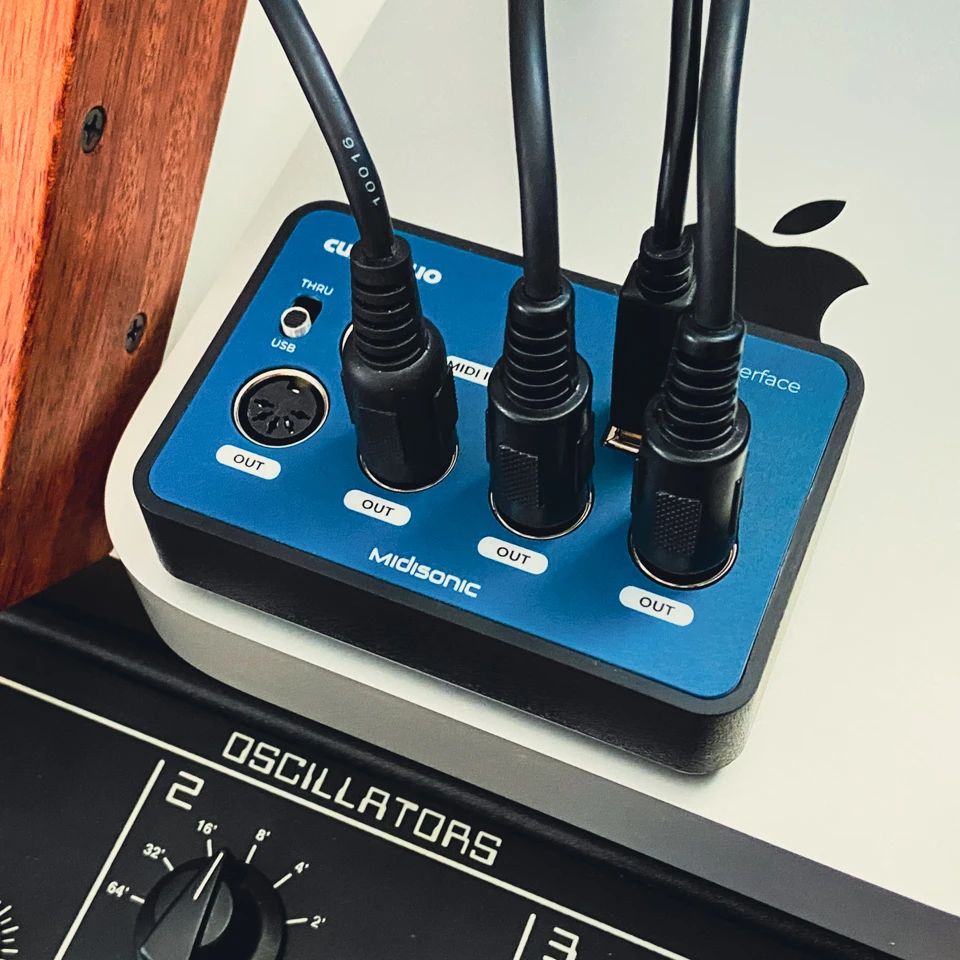It’s a little like the world’s smallest Octatrack alternative. Hook a cubit duo into OP-Z with a single cable, and you can unlock the OP-Z’s control and sequencing capabilities.
The MeeBlip owner community actually pointed us to this capability rather than the other way around.
Here’s a great video showing how it works. It features cubit go, which we’ve discontinued in favor of cubit duo (which adds a standalone MIDI thru mode). But cubit duo has the exact same interface features, so all the information here applies. (Thanks to Matt Greer for the video! Uh, I learned something!)
The oplab module is cool and ultra-compact, plus it does CV. But it also costs twice as much as a cubit duo, and it doesn’t work with any of your other stuff. It has only one output jack for MIDI. And it doesn’t have full-sized MIDI DIN ports available, which means the dreaded cable/adapter hunt, followed by the “which minijack MIDI wiring does this adapter have” mystery. (There is a standard, but it was adopted late, so not everything works the same way.)
Basically, the cubit has convinced me to start playing with the OP-Z’s MIDI features. And they’re pretty cool, too.
Input: Plug in the cubit duo, and you can control your OP-Z with MIDI input, plus record that MIDI to tracks – so you could plug a keyboard with some knobs on it into the cubit’s IN jack and play into the OP-Z. That’s nice for those of us who have trouble soloing on those little OP-Z keys!
Output: The OP-Z is also a clock source and 16-track MIDI sequencer. And you can send clock. So this means the cubit duo right away gives you four outputs, meaning you just turned your OP-Z into a cute little hub for a small live rig. You can toggle sync output on the OP-Z and send out those four OUT jacks. And if you want to use the OP-Z as a sequencer, you can do that, too.
Thru/echo: A prospective buyer just asked us about this. The OP-Z also has a “midi echo” toggle; if you turn that on, anything sent to the input (the IN on cubit duo) will go to the output (all four OUTs on cubit duo).
It’s best to consult Teenage Engineering’s manual on this:
https://teenage.engineering/guides/op-z/midi
But there are some surprisingly advanced features in there, including some additional options you can customize via app or JSON file.
Anyway, bottom line – cubit duo input lets you play/control the synth. cubit duo outputs (all four) let you send sync, sequencer info, or both. All you need is a USB-C to USB-B cable (or a USB-A to USB-C cable, plus a USB-A to USB-B adapter).
Those USB B-to-C cables are easy to find now, though – I just picked up one at a mall superstore. (“B” is the square-looking port on the top of cubit. “A” is the flat rectangular one you know as the generic USB ports on older laptops; “C” the futuristic oval one on new notebooks and newer smartphones and tablets.)

About cubit duo
While we’re on the topic, me clarify some stuff after feedback on our recent cubit duo launch. We made cubit duo to be as simple a MIDI interface and thru box as possible. There are other boxes with more advanced MIDI capabilities. We just wanted something you could plug in for 90% of the stuff you do every day without too much thought. Connect a USB cable, without hunting for power, and you’ve got a USB MIDI interface for just about anything.
The fact that this works with OP-Z is a great example of that, and you didn’t need anything special to make it work (including any special knowledge).
This box is meant to be simple, not to do everything. We don’t currently make a cubit device that supports USB host – that’s the ability to plug in devices that have USB MIDI but not the full-sized MIDI DIN. The USB B port on cubit duo is just for power (standalone) or use as an interface (in USB mode).
If you do want USB host, let me point you to Retrokits’ RK006, for instance, which connects to most of the stuff the cubit duo can’t.
But, but – yeah, we kept cubit duo as inexpensive as we could, it’s lightweight and rugged, and it’s a single device that works with one cable that connects to all the full-sized MIDI DIN stuff you use without adapters or special cables.
Honestly, it was so obvious to me that it took a while for James the MeeBlip engineer and co-founder to convince me it didn’t already exist like this. (It really doesn’t.)
Buy in North America / worldwide: https://meeblip.com/products/meeblip-cubit-duo
Buy in Europe (EU, UK, and neighbors): https://meeblip.eu/products/meeblip-cubit-duo
I’ll post the official manual shortly.